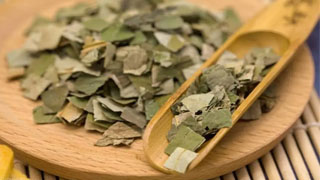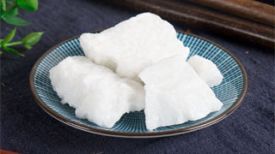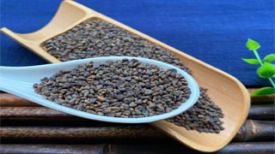
1. Alias
Lotus leaves, lotus root leaves.
2. Plant morphology
Perennial aquatic herb. The rhizomes are full and thick, with enlarged internodes and numerous longitudinal ventilation holes inside, while the adventitious roots have tendrils outside. Leaves grow on the nodes and protrude from the water surface; The petiole grows in the center of the leaf back, thick, cylindrical, and prickly; The leaves are round, with a diameter of 25-90 centimeters, and the entire margin is or slightly wavy. The upper part is pink green, and the lower part has veins that shoot out from the center. There are 1-2 forked branches. The flower is solitary at the top of the peduncle, with the peduncle being equal or slightly longer than the petiole, and scattered small spines. The flower has a diameter of 10-20 centimeters, is fragrant, red, pink, or white, and has elliptical or inverted petals that are 5-10 centimeters long and 3-5 centimeters wide. The stamens are numerous, the anthers are strip-shaped, and the filaments are slender. It grows under the receptacle, with many carpels buried in the enlarged receptacle. The ovary is elliptical, and the style is extremely short. After flowering, it forms a "lotus pod" with a conical shape, a diameter of 5-10 centimeters, and 20-30 small holes. Each hole contains one fruit, and the nut is oval or ovoid in shape, measuring 1.5-2.5 centimeters in length. The skin is leathery, hard, and black brown when ripe. The seeds are oval or elliptical in shape, measuring 1.2-1.7 centimeters in length, with a red or white seed coat. The flowering period is from June to August, and the fruiting period is from August to October.
3. Origin distribution
Born in swamps, ponds, or paddy fields, wild or cultivated. Widely distributed in various parts of the north and south.
4. Harvesting and processing
Harvested in summer and autumn, when sun dried to 70-80%, remove the petiole, fold into a semi-circular or fan-shaped shape, and dry.
5. Characteristics of medicinal herbs
The leaves are semi-circular or fan-shaped, and when unfolded, they form a quasi circular shape, with the entire edge or slightly wavy, and a diameter of 20-50 centimeters. The upper surface is dark green or yellow green, relatively rough, and the lower surface is light gray brown, relatively smooth, with 21-22 thick veins that shoot out from the center to the periphery, and a protruding stem residue in the center. Crispy and easily broken. Slightly clear aroma, slightly bitter taste.
6. Sexual Taste Returning to the Classics
Flat in nature, bitter in taste. Return to the liver meridian, spleen meridian, and stomach meridian.
7. Effect and Function
Clearing heat and dampness, promoting clear yang, cooling blood and stopping bleeding. A heat clearing and blood cooling medicine classified under the category of heat clearing drugs.
8. Clinical application
Oral administration: decoct soup, dosage 3-10g (fresh 15-30g), lotus leaf charcoal 3-6 g, or add to pills or powder. External use: Apply in moderation, massage or boil and wash with water. Used for summer heat induced thirst, summer dampness diarrhea, spleen deficiency diarrhea, blood heat vomiting, rectal bleeding, lotus leaf charcoal for astringency and stasis control, used for bleeding and postpartum dizziness.
9. Pharmacological research
It has the effects of reducing cholesterol and weight, lowering blood pressure, antioxidation, and clearing free radicals; The alkaloid components in lotus leaves have antispasmodic effects on smooth muscles, as well as antiviral, anti mitotic, anti-inflammatory, and anti allergic effects; Lotus leaves also have a hemostatic effect.
10. Chemical composition
Containing ingredients such as spotted Asian poppy alkaloids, lotus leaf alkaloids, original lotus leaf alkaloids, racemic American poppy alkaloids, cherine alkaloids, citric acid, malic acid, etc.
11. Usage taboos
Not yet clear.
12. Related prescriptions
① Treating Yang water swelling: Lotus leaves are burnt and ground into powder. Take 6 grams per dose, adjust to rice drink, and take three doses a day. (Essentials of Diagnosis and Treatment)
② Treating Thunder Head Wind: 30g each of Cistanche and Atractylodes macrocephala, one lotus leaf. At the end. Take 15 grams each time, boil in water, and take after eating. Or burn a whole lotus leaf, grind it finely, and add it to the decoction for oral administration. (Health Treasure Mirror - Qingzhen Decoction)
③ Treating vomiting blood is not limited: a. Defrost lotus leaves with frost, boil and grind them into powder, and take 6 grams of new water. (Behind the Elbow); b. Seven tender lotus leaves, wearing water suits. (Gangmu)
④ Treating vomiting blood and hemoptysis: Regardless of the amount of lotus leaves, apply one flavor, roast, mash into powder, and mix with 6 grams of rice. (Qingjin San in the "General Record of St. Francis")
⑤ Treating yang by crossing yin, resulting in vomiting and bleeding: dividing lotus leaves, mugwort leaves, cypress leaves, and Rehmannia glutinosa into equal parts. Upstream research, chicken meatballs are big. Take one pill each time and boil it in water. (Four Life Pills from "The Good Women's Formula")
⑥ Postpartum collapse after treatment: 30g lotus leaves (on July 7th), 60g deer antler gum, crushed and stir fried to make it yellow and dry. Mash the medicine into fine Luo powder, and add 6 grams of warm wine before each meal. (Holy Blessing Formula)
⑦ Treating anal prolapse without retraction: Take 6 grams of lotus leaves, roast, grind, and drink with alcohol, then continue to pour lotus leaves into powder and sit on it. (The Good Formula of Experience)
⑧ Zhichi You Huo Dan: Freshly grow lotus leaves, crush them, and apply salt to them. ("Extracting Mysterious Formulas")
⊙ The content of the article is for clinical reference only. Non TCM professionals are not allowed to test drugs.


